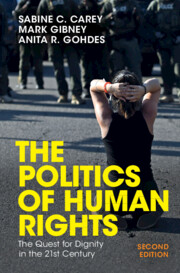Refine search
Actions for selected content:
1253 results
1 - A New Framework for Transnational Legalisation
-
- Book:
- Making and Breaking the Rules in Business and Human Rights
- Print publication:
- 22 January 2026, pp 18-55
-
- Chapter
- Export citation
Introduction
-
- Book:
- Making and Breaking the Rules in Business and Human Rights
- Print publication:
- 22 January 2026, pp 1-17
-
- Chapter
- Export citation
1 - Washington and The Hague
-
- Book:
- Above the Law
- Published online:
- 20 November 2025
- Print publication:
- 22 January 2026, pp 1-26
-
- Chapter
- Export citation
2 - Corporations, Human Rights and the Governance Gap
-
- Book:
- Making and Breaking the Rules in Business and Human Rights
- Print publication:
- 22 January 2026, pp 56-85
-
- Chapter
- Export citation
Clarifying Indigenous Approaches to Ecocide
-
- Journal:
- Transnational Environmental Law / Volume 14 / Issue 3 / November 2025
- Published online by Cambridge University Press:
- 11 December 2025, pp. 659-689
-
- Article
-
- You have access
- Open access
- HTML
- Export citation
Global South cities: borderline international legal personality, financialised local governance and urban resistance
-
- Journal:
- International Journal of Law in Context , First View
- Published online by Cambridge University Press:
- 02 December 2025, pp. 1-16
-
- Article
-
- You have access
- Open access
- HTML
- Export citation

Above the Law
- The United States and the International Criminal Court
-
- Published online:
- 20 November 2025
- Print publication:
- 22 January 2026
The End of Autocratic Norm Adaptation? US Retrenchment and Liberal Norms in Illiberal Regimes
-
- Journal:
- International Organization / Volume 79 / Issue S1 / December 2025
- Published online by Cambridge University Press:
- 20 November 2025, pp. S224-S241
- Print publication:
- December 2025
-
- Article
-
- You have access
- Open access
- HTML
- Export citation
Territorial Integrity As an Etiquette of Thieves: Non-conquest in Nineteenth-Century Imperialism
-
- Journal:
- International Organization , First View
- Published online by Cambridge University Press:
- 20 November 2025, pp. 1-27
-
- Article
-
- You have access
- Open access
- HTML
- Export citation
16 - Collective Action and the Right to Strike
- from Part IV - Collective Labour Rights
-
- Book:
- Labour Law
- Published online:
- 02 October 2025
- Print publication:
- 20 November 2025, pp 704-760
-
- Chapter
- Export citation
5 - The “Widening Gap” as a Threat to Human Rights: Manouchehr Ganji
- from Part II - Criticizing Global Inequalities through Human Rights
-
- Book:
- In Defense of Economic and Social Human Rights
- Published online:
- 06 November 2025
- Print publication:
- 20 November 2025, pp 165-192
-
- Chapter
- Export citation
3 - Sources of Law
-
- Book:
- The Law and Practice of International Administrative Tribunals
- Published online:
- 27 October 2025
- Print publication:
- 13 November 2025, pp 52-84
-
- Chapter
- Export citation
Self-Presentation in International Law: On Reputation and Interpretation
-
- Journal:
- German Law Journal ,
- Published online by Cambridge University Press:
- 13 November 2025, pp. 1-36
-
- Article
-
- You have access
- Open access
- HTML
- Export citation

The Politics of Human Rights
- The Quest for Dignity in the 21st Century
-
- Published online:
- 12 November 2025
- Print publication:
- 06 November 2025
-
- Textbook
- Export citation
Dirty hands, savage enemies, and bad apples: A taxonomy of war crimes apologia
-
- Journal:
- Review of International Studies , First View
- Published online by Cambridge University Press:
- 12 November 2025, pp. 1-20
-
- Article
-
- You have access
- Open access
- HTML
- Export citation
The Taiwan Constitutional Court’s Evolving Engagement with International Law
-
- Journal:
- Asian Journal of International Law , First View
- Published online by Cambridge University Press:
- 11 November 2025, pp. 1-29
-
- Article
-
- You have access
- Open access
- HTML
- Export citation
11 - Security and International Law
- from Part II - The Traditional Security Agenda
-
- Book:
- Understanding International Security
- Published online:
- 11 October 2025
- Print publication:
- 30 October 2025, pp 210-229
-
- Chapter
- Export citation
1 - Introduction
-
- Book:
- Population Control as a Human Right
- Published online:
- 09 October 2025
- Print publication:
- 23 October 2025, pp 1-16
-
- Chapter
- Export citation
6 - Crisis and Expansion of Human Rights in the 1970s
-
- Book:
- Population Control as a Human Right
- Published online:
- 09 October 2025
- Print publication:
- 23 October 2025, pp 110-128
-
- Chapter
- Export citation

Understanding International Security
- Theory and Practice
-
- Published online:
- 11 October 2025
- Print publication:
- 30 October 2025
-
- Textbook
- Export citation
